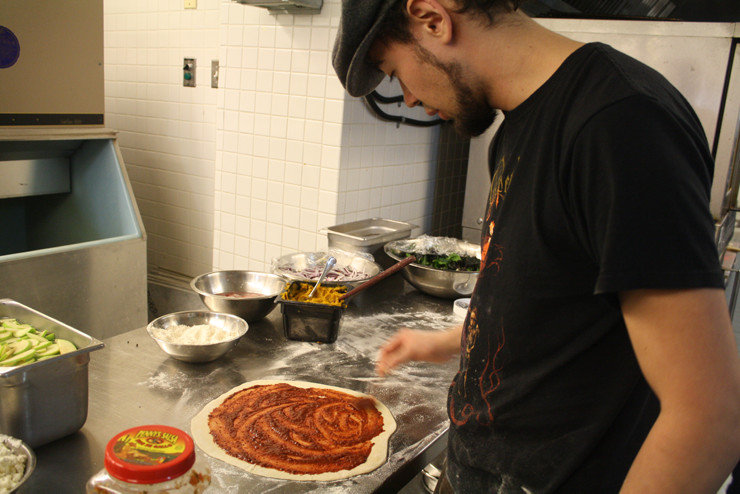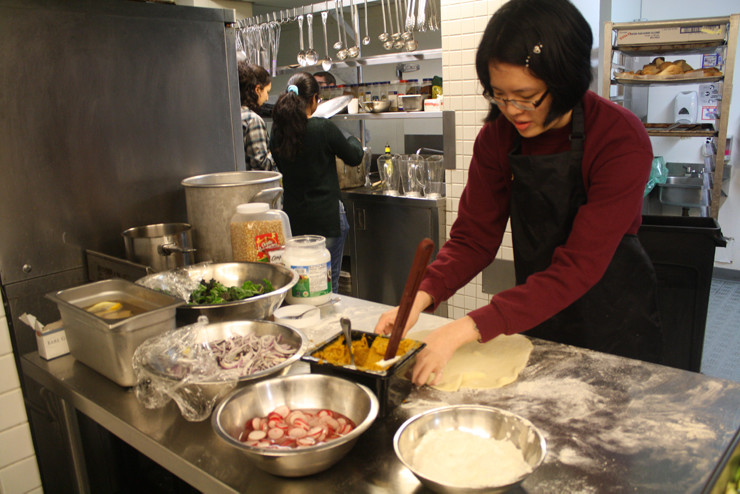Pizza night in the great Green machine
By Will Preston

It's 5:30 PM, and Riley Iwamoto has 48 pizzas to bake. The 31-year-old MA student is standing in the kitchen at UBC's Green College, overseeing a small army of students as they toss dough, chop chicken, and mash blackberries into sauce. Dinner is usually provided for the hundred-odd grad, law, and PhD students who call Green their home. But tonight is Wreck-Tower Cup, a friendly tournament with another grad college, St. John's. Upstairs, over 150 students are facing off in ping pong, foosball, and artistic contests. And downstairs, Riley has volunteered to help feed them all.
But it's not about the food
Green College is perched on the northwest edge of campus, the Museum of Anthropology to one side and Wreck Beach on the other. A rustic-looking collection of rooms clumped cozily around a central courtyard, Green is a wildly diverse intellectual hub. A public lecture series includes global warming activists and Supreme Court Justices. Dinner conversation (held in a cavernous great hall whose arched timbers suggest a cathedral, or the hull of an overturned ship) ranges from Caravaggio to free will.
And then there are the residents. Riley, pizza maestro, is in the Urban Planning program. Lucy, spooning sauce onto the dough, is in Library Studies; Brie, waiting to whisk the food upstairs, Theoretical Physics. This assembly line is a perfect microcosm of Green: a smorgasbord of disciplines and interests, all working together as one.
Riley's life has been a smorgasbord in itself. He's worked in the food industry since 2008, when Cirque du Soleil hired him as a dishwasher. (Today he slings pizza at Corduroy, in Kits.) At Green, he helps manage the kitchen and tends an herb garden on the grounds—rosemary, parsley, chocolate mint. Meanwhile, his studies have swept from computer animation to architecture; he snowboards ("recklessly"); and he constructs tiny, intricate models. The one he shows me is a robot, dabbed in purples and whites, light and delicate as a butterfly wing.
His true passion, though, is Planning. He's concerned about self-sufficiency, environmentalism, making cities less reliant on cars. Recently, he participated in a national competition to redesign a hellishly congested area of Atlanta, linking skyscrapers, fast-food joints, and a university across a twelve-lane highway. For him, these issues are about more than efficiency. They're about connecting communities.

How talk bridges gaps
Green does the same thing with people. It bridges gaps between disciplines and cultures; students from Canada and the US live alongside those from Russia, Venezuela, Pakistan. Riley refers to it as "interdisciplinary crosspollination." In North America, he says, people aren't used to sharing space and resources. Living at Green not only exposes you to radically different people, but teaches you to organize a community with them. By living here, "we're all getting training in planning."
And so, downstairs in the kitchen, the great Green machine revs itself and gets ready to go. An Indian girl pours drinks with a New Yorker; an architecture student sings to herself as she lays toppings on the pies. And at the centre of it all is Riley, moving like a dancer through the maelstrom, the pizza paddle light in his hands.
A native of Virginia, Will Preston has since lived in Oregon, England, and the Netherlands. He has written extensively on travel, music, and history, and was recently featured in Glassworks Magazine and PRISM International. He is an MFA candidate at the University of British Columbia and a Green College Resident Member. His piece originally appeared in the March 2016 edition of University Hill Connections, a UBC-based publication.